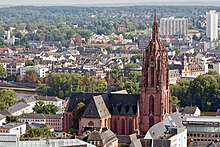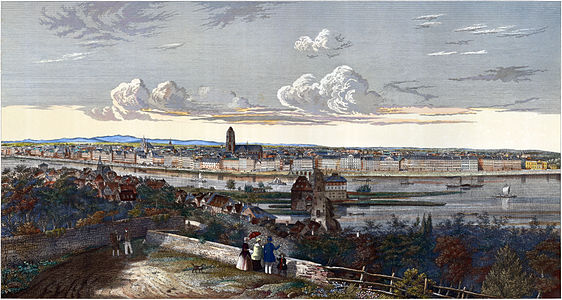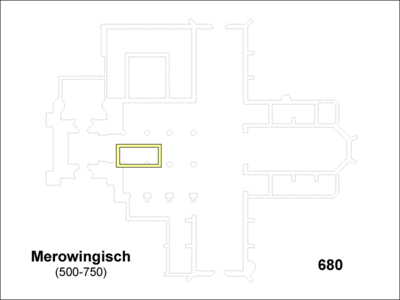Frankfurt Cathedral
You can help expand this article with text translated from the corresponding article in German. (June 2011) Click [show] for important translation instructions.
|
| Frankfurt Cathedral | |
|---|---|
| Imperial Dom of Saint Bartholomew | |
Kaiserdom Sankt Bartholomäus | |
 | |
 | |
| 50°6′38″N 8°41′6″E / 50.11056°N 8.68500°E | |
| Location | Domplatz 1 Frankfurt am Main |
| Country | Germany |
| Denomination | Roman Catholic |
| Website | www |
| History | |
| Status | Cathedral (also parish church) |
| Dedication | Bartholomew the Apostle |
| Relics held | Pieces of Saint Bartholomew's skull |
| Architecture | |
| Functional status | Active |
| Style | Gothic |
| Years built | c. 7th century (original building) |
| Completed |
|
| Specifications | |
| Number of towers | 1 |
| Tower height | 95 meters (312 ft) (including spire) |
| Administration | |
| Province | Cologne |
| Diocese | Limburg |
| Laity | |
| Director of music | Andreas Boltz |
Frankfurt Cathedral (German: Frankfurter Dom), officially Imperial Dome of Saint Bartholomew (German: Kaiserdom Sankt Bartholomäus), is a Roman Catholic Gothic church located in the heart of Frankfurt am Main, Germany. It is dedicated to Saint Bartholomew.
It is the largest religious building in the city and a former collegiate church. Despite its common English name, it has never been an actual cathedral (episcopal see). Still, it is called the Kaiserdom (an "imperial great church" or imperial cathedral) or simply the Dom due to its importance as former election and coronation church of the Holy Roman Empire.[1] As one of the significant buildings of the Empire's history, it was a symbol of national unity, especially in the 19th century.
The present church is the third church on the same site. Since the late 19th century, excavations have revealed buildings that can be traced back to the seventh century. The cathedral's history is closely linked with the general history of Frankfurt and Frankfurt's old town because it was associated with the religious counterpart of the Royal Palace in Frankfurt.
History
[edit]
Frankfurt Cathedral was an imperial collegiate church, termed Dom in German – a synecdoche for all collegiate churches used totum pro parte also for cathedrals -, and thus traditionally translated as cathedral in English. St. Bartholomew's is the main church of Frankfurt and was constructed in the 14th and 15th centuries on the foundation of an earlier church from the Merovingian time.[2]
Since 1356, when the Golden Bull of 1356 was issued by Charles IV, Holy Roman Emperor, emperors of the Holy Roman Empire were elected in this collegiate church as kings in Germany, and from 1562 to 1792, emperors-elect were crowned here.[3][4] The imperial elections were held in the Wahlkapelle, a chapel on the south side of the choir (Hochchor) built for this purpose in 1425 (See the Plan to the right) and the anointing and crowning of the emperors-elect as King of the Romans took place before the central altar–believed to enshrine part of the head of St. Bartholomew – in the crossing of the church, at the entrance to the choir (See the Plan to the right).
When the city of Frankfurt secularized, it appropriated the remaining Catholic churches and their endowments of earning assets, however, leaving the usage of the church buildings to the existing Catholic parishes. Thus, St. Bartholomew's became the city's dotation churches, owned and maintained by the city but used by Catholic or Lutheran congregations.
St. Bartholomew's was seen as symbol for national unity in Germany, especially during the 19th century. Although it had never been a bishop's seat, it was the largest church in Frankfurt, and its role in imperial politics, including the crowning of medieval German emperors, made the church one of the most important buildings of Imperial history.
In 1867, St. Bartholomew's was destroyed by a fire and rebuilt in its present style.[5][6] During World War II, between October 1943 and March 1944, the old town of Frankfurt, the biggest old Gothic town in Central Europe, was devastated by six bombardments of the Allied Air Forces. The most significant losses occurred in an attack by the Royal Air Force on 22 March 1944, when more than a thousand buildings of the old town, most of them half-timbered houses, were destroyed.
St. Bartholomew's suffered severe damage; the interior was burned out completely. The building was reconstructed in the 1950s. The height of the spire is 95 meters (312 ft).
Frankfurt Cathedral Choir School
[edit]The Frankfurt Cathedral Choir School (German: Frankfurter Domsingschule), founded in 2011, is a mixed ecumenical children's and youth choir, which accompanies not only mass and evensongs, but also official receptions and openings.[7] The Frankfurter Domsingschule offers any singer, regardless of their religious affiliation, age-based, free vocal basic training at regular rehearsals and valuable one-on-one and group vocal training or early musical education. This extensive basic training is unique for Frankfurt.
Notable people associated with the cathedral
[edit]- Conrad III of Dhaun, former provost
- Madern Gerthener, stonemason and architect who designed the cathedral
- Johannes Jeep, organist
- Joseph Weyland, Bishop of Fulda
- Hans Abel, artist contributing to the stained glass
- Notable burials
- Johannes Karl von und zu Franckenstein, Prince-Bishop of Worms
- Günther von Schwarzburg, anti-king and member of the House of Schwarzburg
Gallery
[edit]-
View from the south after the fire of 1867
-
Frankfurt on the Main: 1940's Aerial photograph from the northeast; Cathedral (left); in the background: St. Paul's Church
-
The tower
-
View from Sachsenhaeuser Berg (Mountain of Sachsenhausen) to the north, 1845
-
The organ
-
Vaulted ceilings
-
Plan
-
Historical development of the current building; colors distinguish its various architectural styles.
-
A rooftopper on top of Frankfurts Kaiserdom
-
1944 Aerial photograph of the cathedral during World War 2
See also
[edit]References
[edit]- ^ "Kaiserdom St. Bartholomäus". frankfurt.de (in German). Archived from the original on 4 July 2023. Retrieved 2 April 2021.
- ^ Düring, Ursula (23 September 2010). "Wo Kaiser und Könige gekrönt wurden". Mainpost (in German). Archived from the original on 31 August 2024. Retrieved 2 April 2021.
- ^ "Dom :: Dompfarrei St. Bartholomäus". Dompfarrei St. Bartholomäus (in German). Archived from the original on 31 August 2024. Retrieved 2 April 2021.
- ^ "Als im Frankfurter Dom die Kaiser und Könige gewählt wurden". katholisch.de (in German). Archived from the original on 31 August 2024. Retrieved 2 April 2021.
- ^ "Dom Frankfurt a. M." Dombaumeister E.v. (in German). 21 April 2014. Archived from the original on 31 August 2024. Retrieved 2 April 2021.
- ^ "Domturm Frankfurt am Main, Geschichte". Domturm Frankfurt am Main (in German). Archived from the original on 31 August 2024. Retrieved 2 April 2021.
- ^ "Frankfurter Domsingschule :: Geschichte der Frankfurter Domsingschule". Frankfurter Domsingschule (in German). Archived from the original on 17 April 2021. Retrieved 2 April 2021.
Further reading
[edit]- Rösmann, Tobias (20 December 2019). "Wahlkapelle im Frankfurter Dom: Schlicht und ergreifend". Frankfurter Allgemeine Zeitung (in German). Retrieved 2 April 2021.
- Göpfert, Claus-Jürgen (10 February 2020). "Kran stürzt auf das Dach des Doms". Frankfurter Rundschau (in German). Retrieved 2 April 2021.
External links
[edit]- Dompfarrei St. Bartholomäus
- Domturm
- Frankfurter Domsingschule
- "Dommuseum Frankfurt – Dome Museum". Museumsufer Frankfurt. Retrieved 21 December 2022.










